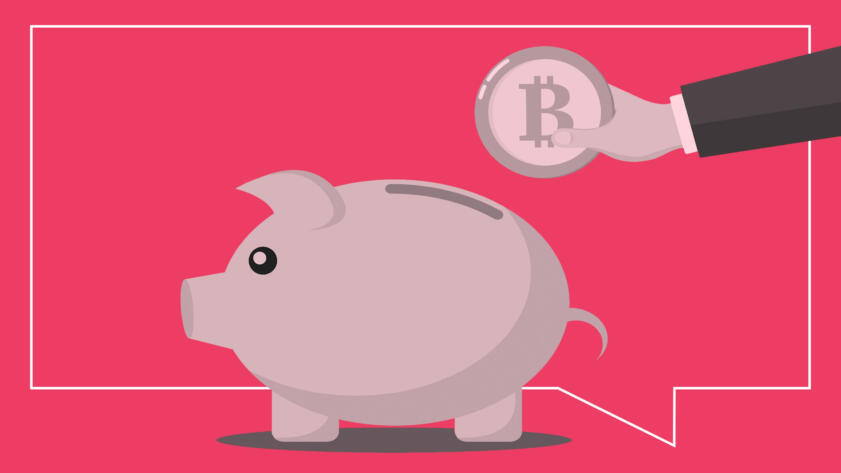The Discord servers and subreddits are a frenzy of graphs, memes, and speculation about the next bull market. Twitter CEO Jack Dorsey said he believes bitcoin can bring about “world peace.” And the pro-Trump “magacoin” was launched for more than 1,000 early adopters whose personal information was quickly exposed online due to poor website security. (The organizers did not respond to a request for comment.)
All in all, it’s been a normal couple of weeks in the world of cryptocurrency.
The value of digital currencies fluctuates wildly at the whim of erratic billionaires, rumors, and the machinations of unregulated online exchanges. During the last year, the overall cryptocurrency market capitalization has swung from $293.1 billion in July 2020 up to a record high of $2.5 trillion in May 2021 and then down to $1.5 trillion as of late July, according to CoinMarketCap, a crypto data platform.
Despite that volatility, investors are increasingly buying into the currencies.
Reliable numbers are hard to come by, but industry surveys estimate that anywhere from 8 to 14 percent of Americans own cryptocurrency. And over the last year alone significantly more professional financial advisers say they are encouraging clients to invest in digital currencies, according to an annual survey by the Financial Planning Association.
But what are the drawbacks?
The Markup interviewed behavioral economists, industry analysts, and investors. Many cautioned that crypto markets increasingly resemble rigged casinos. But let’s start with the basics.
What Is Cryptocurrency?
Cryptocurrencies are byproducts of blockchain networks and vary widely in purpose and value. Bitcoin, the most well-known digital currency, is illustrative of how the technology works.
A blockchain is a cryptographic system designed to record information—in bitcoin’s case, financial transactions—across a distributed network of computers in such a way that the information can’t be faked, censored, or controlled by a central entity like a bank.
When you make a bitcoin transaction, you “sign” it with the private cryptographic key associated with your bitcoin wallet and send it to the public address of the person you’re paying. Then the vast network of computers set up to verify transactions gets to work to solve the necessary cryptographic problems to prove that the transaction is legitimate, and if it is, add it to the public blockchain, which anybody can verify at any time.
In order for this system to work, there has to be some incentive for the people—known in this case as bitcoin miners—who own the computers that hum day and night, burning huge amounts of energy, to solve the cryptographic problems and maintain the integrity of the blockchain. That’s where the coins come in.
When a miner’s network successfully solves a cryptographic puzzle, that miner is awarded a bitcoin. The system is designed so that only 21 million bitcoins will ever be mined, and it becomes increasingly difficult to mine them the more there are in circulation, which creates scarcity and, in theory, increased value. About 18.8 million have been mined so far, with the last expected to be mined around 2140.
Though there are many different cryptocurrencies—other popular coins include ether, dogecoin, XRP, and litecoin—they all basically work the same way.
Why Does Their Value Fluctuate So Much?
None of that, though, explains why bitcoin or other cryptocurrencies are valued as highly as they are (a bitcoin was worth $37,968 as of the evening of July 27) or why those values are so volatile.
The first simple economic reason that cryptocurrencies are volatile is that they’re new and nobody is entirely sure how to value them yet.
You can assign a value to stocks or bonds because they have cash flows like dividends and future interest payments that can be measured. They’re also associated with entities like companies and governments that are legally required to report certain key metrics, said Vivek Singh, a professor of finance at the University of Michigan–Dearborn.
“There is no cash flow associated with cryptocurrency,” he said. “It seems to be purely a behavioral phenomenon. You buy thinking somebody else will value it more than you did, but you have no idea why.”
You buy thinking somebody else will value it more than you did, but you have no idea why.
Vivek Singh, University of Michigan–Dearborn
That lack of an inherent measure of value also means prices can change rapidly with major news, like reports about pending government regulation. Even minor news, such as Elon Musk’s announcement that Tesla would accept bitcoin in exchange for its vehicles (which pushed bitcoin up 5 percent), his subsequent announcement that Tesla would stop accepting bitcoin (the value dropped 14 percent in two hours), and most recently his statement that Tesla would “most likely” accept bitcoin again at some point in the future (driving the price up more than 12 percent).
If they buy or sell at the right time, speculative cryptocurrency traders can make significant profits. If enough of them make the same trades, it can trigger cascades that lead to huge bull or bear runs. Those runs can make or break fortunes.
“Crypto is probably the most volatile asset that any investor has ever owned,” said Matt Hougan, chief investment officer for the index fund Bitwise Asset Management. But a “small allocation”—one to 2 percent for most people—of established currencies like bitcoin and ether “in an otherwise diversified portfolio of stocks and bonds can be a good idea for the right investor.”
The real risk comes when individuals stake more than they can afford to lose quickly and when they delve into newer coins and the world of unregulated exchanges.
What Does a Lack of Regulation Mean?
Here’s where the real risks come in.
On May 19, as cryptocurrencies began to fall rapidly in value, Binance, the largest online exchange, measured by transaction volume, froze. It locked users out of their accounts as prices slipped, preventing them from selling stakes and resulting in life savings being wiped away in a matter of hours. Other exchanges also went offline amid the panic.
Binance and similar exchanges are unregulated. And while certain of their derivative offerings aren’t allowed in the U.S. and some other jurisdictions, it’s easy for traders to get around those restrictions by using virtual private networks (VPNs). Binance also doesn’t have a headquarters, making it exceedingly difficult for the hundreds of victims currently trying to sue the company to find the proper court through which to attempt to recover their losses.
Binance did not respond to The Markup’s request for comment. A Binance spokesperson previously told The Wall Street Journal that the company “took immediate steps to engage with users affected by the outage … [and] we remain happy to speak to anyone who reaches out to us with a concern about the outage.”
The unregulated exchanges also pose quieter, daily risks.
Many exchanges, for example, have started offering complicated derivatives like leveraged buys. An investor who believes the price of Coin X is about to surge can put down a relatively small amount of money, say $1,000, and purchase $10,000 or more of Coin X on a 10 to 1 leverage. The exchange lends the additional $9,000, on which it will likely charge interest.
If Coin X increases in value, say by 50 percent, everything is great. The account holder pays back the $9,000 they borrowed plus interest and a fee. They keep their initial $1,000 investment and the additional $5,000 they made in profit—far more than they could have gotten with an initial investment of only $1,000.
But there are several ways things can go wrong. Most exchanges list the daily interest rates they charge on leveraged loans, and the numbers can appear quite small at first. For example, an exchange may offer a leveraged loan on Coin X with a daily interest rate of just 0.3 percent. But if you annualize that, a borrower will owe more than 100 percent in interest at the end of the year.
If Coin X dips, things get even worse. The broker triggers a margin call—a set price at which the investor must pay the lender back in full, potentially leading to losses the investor can’t afford. A coin need only drop 10 percent in value to wipe out the principal investment on a 10 to 1 leveraged loan, and some exchanges are offering leverages as high as 100 to 1.
The danger of those leveraged trades is compounded by the fact that professional traders and exclusive pay-to-play groups have significant power to influence when values go up and down, especially for the smaller coins that attract the most speculation.
Trading volume data from Binance, for example, shows that the highest rates of activity come during working hours, Monday through Friday, in the U.S., demonstrating that professionals dominate the platform, said Carol Alexander, a University of Sussex finance professor who studies cryptocurrency markets.
I don’t advise anybody to try to do their own day trading because they’ll become bananas, and what I mean by that is food for the gorillas.
Carol Alexander, University of Sussex
“You start off by buying some bitcoin, then you look a bit further and it’s a little bit like the door to the secret garden,” Alexander said. Then as soon as you log on to an exchange like Binance, you’re met with a pop-up ad offering tutorials for trading special products that promise to bring even greater wealth for little money down. “They allow any type of training on types of products that don’t exist in traditional financial markets and they make them up. People think they understand, when actually they don’t.”
Then there are groups like BlackDragon, which act as venture firms, arranging exclusive deals and insider information for wealthy individuals. Becoming a “White Dragon,” which grants you access to 60 percent of the group’s deals, costs 250 BlackDragon tokens, which currently go for about $10.40 each, or $2,600 total. Gaining access to 100 percent of the deals as a “Black Dragon” currently costs about $104,000.
Those who can’t afford BlackDragon memberships are left to hope that the coin they just invested in isn’t being manipulated behind the scenes.
“I don’t advise anybody to try to do their own day trading because they’ll become bananas, and what I mean by that is food for the gorillas,” Alexander said.
So What’s the Safest Way to Invest in Crypto?
In some specific ways, investing in crytpo is kind of like other forms of investment: Day trading and other attempts to play the market are risky, but experts say there are safer ways to dip in.
Research from the Blockchain Research Lab, in Hamburg, Germany, shows that the majority of active crypto traders who try to outsmart the market would be better off buying bitcoin and holding onto it.
Even after the precipitous drops of the past few months, a bitcoin is worth about $27,000 more today than it was a year ago, when a single coin was going for just under $11,000. Most professional investors believe this is currently a bear market and that bitcoin will continue its erratic climb in value for years.
David Yermack, a New York University business professor who teaches about cryptocurrency, said investing a small amount in the digital coins may make sense for young people with significant disposable income—but not necessarily those working in tech, because an economic downturn in the industry could threaten both their jobs and their crypto investments.
The Blockchain Research Lab study found that the vast majority of crypto investors were male (77 percent) with an average age of 38 and that, on average, they invested 60 percent of their net monthly income in digital currencies.
“In many ways, the people who shouldn’t be owning [cryptocurrency] in the first place are most drawn to it,” Yermack said. “A lot of it is risk-loving people who are just drawn to it and excited by the sharp increases and declines. Nobody should be investing in things for excitement.”





